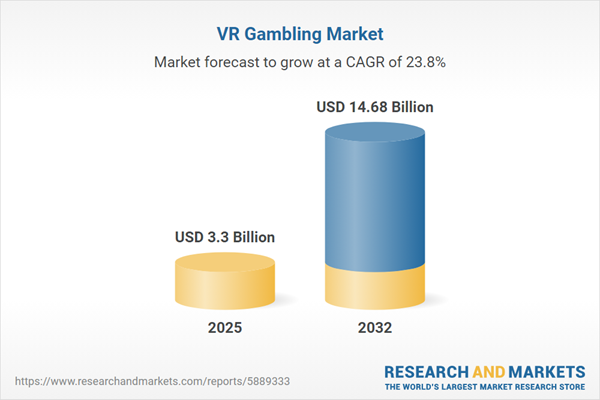Speak directly to the analyst to clarify any post sales queries you may have.
Senior decision-makers shaping strategy in the virtual reality gambling market are contending with fast-moving regulatory reforms, advanced technology integration, and shifting user preferences. Consistent review of compliance demands and operational updates is critical to sustaining a market advantage in this evolving sector.
Market Snapshot: Growth Trends in the VR Gambling Market
The VR gambling market is demonstrating steady expansion, supported by a compound annual growth rate (CAGR) of 23.76% through 2032. This elevated growth outlook strengthens investment and encourages new market entrants, especially as immersive technologies redefine both player experiences and platform capabilities. Operators now deploy advanced interfaces, upgraded graphic environments, and dynamic user engagements to differentiate their offerings. Virtual casinos, interactive lotteries, and evolving poker formats are at the forefront of operator innovation. Meanwhile, sportsbook applications are increasingly favoring features that drive engagement and retention. Collaboration among hardware and software developers is fostering solutions that address compliance and heighten operational efficiencies. The competitive landscape is rapidly intensifying, with operators required to quickly align with both technology upgrades and evolving consumer interests to sustain relevance.
Scope & Segmentation of the Virtual Reality Gambling Market
Comprehensive analysis of the VR gambling market’s structure, areas of innovation, and evolving consumer needs is crucial for guiding capital and strategic priorities. The segmentation below clarifies where opportunities and challenges are emerging:
- Platform Categories: VR casino gaming, digital lotteries, immersive poker, and enriched sportsbook offerings deliver tailored client experiences and brand clarity.
- Payment Models: Freemium platforms, tiered subscriptions, in-app payments, and pay-per-play approaches help adapt to changing regulations and user behavior.
- Device Types: VR consoles, specialized headsets, mobile-integrated solutions, and tethered displays expand audience reach and enable play in varied settings.
- End User Segments: Enterprise platforms meet operator scalability, while individuals demand customization and seamless interactive journeys.
- Applications: Digital advertising, affiliate integration, and in-game commerce enhance operator revenue streams and support user engagement goals.
- Geographic Regions: Market maturity differs by the Americas, Europe, Middle East and Africa, and Asia-Pacific, with significant momentum noted in markets such as the United States, Germany, China, India, Japan, and Australia, reflecting local consumer preferences and compliance requirements.
- Leading Companies: Evolution Gaming Group AB, Playtech PLC, NetEnt AB, Microgaming (Gibraltar) Limited, FunFair Technologies Limited, BetConstruct Limited, SoftSwiss N.V., Unikrn Inc., Habanero Systems, and SlotVR Ltd. continue to drive product innovation and facilitate technical ecosystem integration.
Breakthroughs in graphical quality, live dealer functionality, artificial intelligence, and blockchain are reinforcing transaction security and elevating the user experience. Agile partnerships between hardware and software providers enable quick compliance adaptation and address region-specific operational needs.
Key Takeaways for Senior Decision-Makers
- Advanced VR devices and analytics tools are supporting higher rates of user engagement and streamlining compliance management.
- Artificial intelligence enables audience segmentation, customized content delivery, and more effective resource deployment across user groups.
- Integrating collaborative features and enhanced social interaction promotes greater user loyalty and encourages longer-term platform participation.
- Applying diverse revenue models such as flexible subscriptions gives operators agility to respond to regulatory changes and consumer demand.
- Digital advertising and affiliate solutions are widening operator reach and increasing efficiency in client acquisition and retention.
- Ongoing cooperation between operators and technology partners is essential for operational responsiveness as market trends shift and competition evolves.
Tariff Impact: Policy Changes Influencing VR Gambling Supply Chains
Forthcoming tariffs in the United States for 2025 are prompting VR hardware suppliers to strengthen local manufacturing, mitigating possible supply disruptions. At the same time, operators are focusing on building resilient and diverse revenue channels, including increased use of subscriptions and microtransactions, as they navigate policy and economic changes in their supply networks.
Methodology & Data Sources
Insights in this analysis derive from structured interviews with principal VR equipment vendors, solution providers, and industry regulators, supplemented by quantitative metrics on transactions, capital flows, corporate trading activities, and shifts in regulatory policy that shape sector development.
Why This Report Matters
- Provides operators with actionable recommendations for developing efficient, resilient business strategies and building industry partnerships in a dynamic market.
- Supports compliance management, improves process effectiveness, and helps manage newly emerging supply chain risks for ongoing operational strength.
- Clarifies value of segmentation and monetization methods, identifying opportunities for boosting user engagement and profitability in priority regional markets.
Conclusion
Leveraging the insights in this report, leaders can drive advanced technology adoption, strengthen operational benchmarks, and build compliance agility to remain competitive as the VR gambling market continues to transform.
Additional Product Information:
- Purchase of this report includes 1 year online access with quarterly updates.
- This report can be updated on request. Please contact our Customer Experience team using the Ask a Question widget on our website.
Table of Contents
3. Executive Summary
4. Market Overview
7. Cumulative Impact of Artificial Intelligence 2025
Companies Mentioned
The companies profiled in this VR Gambling market report include:- Evolution Gaming Group AB
- Playtech PLC
- NetEnt AB
- Microgaming (Gibraltar) Limited
- FunFair Technologies Limited
- BetConstruct Limited
- SoftSwiss N.V.
- Unikrn, Inc.
- Habanero Systems Pte. Ltd.
- SlotVR Ltd.
Table Information
| Report Attribute | Details |
|---|---|
| No. of Pages | 180 |
| Published | November 2025 |
| Forecast Period | 2025 - 2032 |
| Estimated Market Value ( USD | $ 3.3 Billion |
| Forecasted Market Value ( USD | $ 14.68 Billion |
| Compound Annual Growth Rate | 23.7% |
| Regions Covered | Global |
| No. of Companies Mentioned | 11 |









